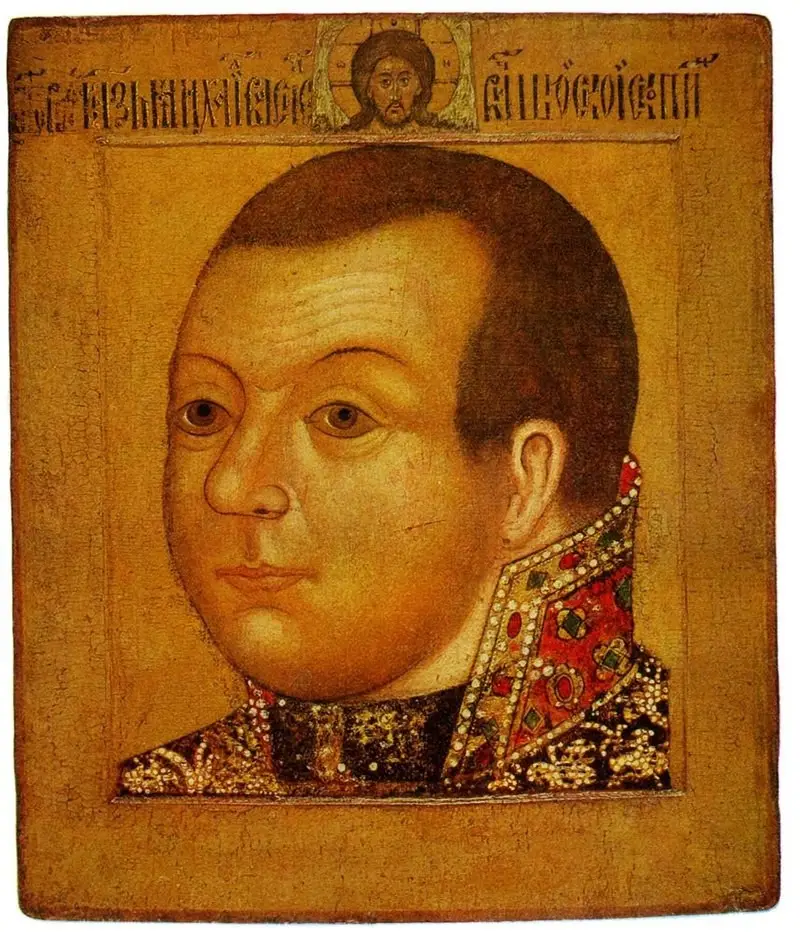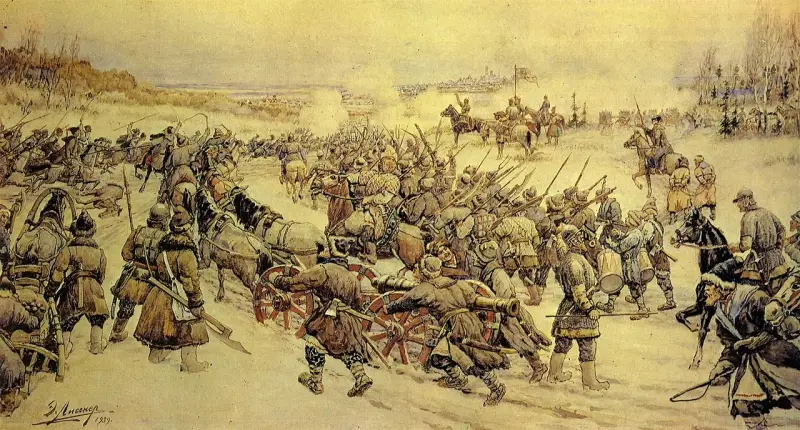Mikhail Skopin-Shuisky: the beginning of the path of Russian Hector

Mikhail Skopin-Shuisky on a 17th century parsun
The name of this man was undeservedly forgotten. If today in Russia you ask a thousand people on the street who Mikhail Skopin-Shuisky is, then at best a few people will answer correctly.
What is the reason? Why is the hero who liberated Moscow and played one of the central roles in the events of the Time of Troubles - the most difficult period of Russian stories - almost forgotten today?
Monuments to him can be counted on the fingers of one hand, and until recently there was only one monument to him.
Maybe historians have ambivalent attitudes towards him? No, they just don’t have any disputes regarding his identity. The classics, starting with Karamzin, Kostomarov, Klyuchevsky and Platonov, unanimously recognize Skopin-Shuisky as a hero equal to Pozharsky. And it was forgotten not because of historians, but because of politicians. Moreover, it was forgotten twice: the first time - with the accession of the Romanovs, and the second - with the coming to power of the Bolsheviks.
What could a man do that both the Romanovs and the Soviet authorities chose to forget about?
What bad did Skopin do first to Romanov?
He turned out to be disadvantageous to the official historiography of the Romanovs simply because he fought against the impostor False Dmitry II. And, as you know, Filaret (in the world Fyodor Romanov) was proclaimed patriarch in the Tushino camp and supported the impostor.
With their accession to the throne, the Romanovs preferred to quickly forget about it, just as they would forget Skopin-Shuisky. In addition, during his lifetime he was the main heir to his uncle Vasily Shuisky, who had no children. Why should the Romanovs once again remember a man who had more rights to the throne than themselves?
People began to remember Skopin-Shuisky only after the publication of Karamzin’s famous “History of the Russian State,” in which the author first tried to comprehend the significance of this prince for the country. Under Nicholas I, several more books dedicated to Skopin-Shuisky were published. Little by little they began to remember him.
A new surge of interest in him came in 1916, when the 300th anniversary of the death of Kuzma Minin was celebrated. At the ceremonial meeting of the Nizhny Novgorod City Duma, dedicated to the memory of Minin, many flattering words were said about Skopin-Shuisky.
It seemed that a number of monuments to the hero would soon appear, but it turned out exactly the opposite. Soon monuments to Bolotnikov, who was defeated by Skopin, began to appear, and he himself was forgotten for the second time.
For the Bolsheviks, Skopin was disadvantageous simply because he was a “tsarist commander” and fought with Bolotnikov, who was declared a “class-correct” hero on a par with Razin and Pugachev. Of the real heroes of the Time of Troubles, the Soviet government decided to single out only Minin and Pozharsky on the basis of the “people’s” principle. But without Skopin’s feat, their feat would have been simply impossible.
Carier start
The future Russian Hector, as the prince was later called, was born on November 8, 1586. His father was a hero of the defense of Pskov from the troops of Stefan Batory. In general, the Skopin family was very ancient and in terms of nobility stood above the line of Vasily Shuisky. So Prince Mikhail had no less rights to the throne than his royal uncle. The prince’s early career was also explained by his nobility: already at the age of 19 he had a boyar’s salary and received the same amount as his 50-year-old uncle, who had not yet ascended the throne.
False Dmitry I, who came to power, brought the young prince closer to him and made him a swordsman. It was a lucrative position, considering that his duties only included keeping the royal sword. It is not clear whether Skopin-Shuisky participated in the conspiracy against False Dmitry I, but he, as Shuisky’s nephew, most likely knew about the conspiracy, but could neither lead it nor hinder it.
After Shuisky took the throne, Bolotnikov’s uprising began, but the tsar did not dare to put his young but gifted nephew at the head of the army. At the head of the army, the new tsar preferred to see his mediocre brother Dmitry, who was immediately defeated by the rebels.
The tsar did not want to appoint his nephew as commander-in-chief not only because of his age (at that time there were also 20-year-old governors), but also because he suspected Mikhail of laying claim to the throne, because he knew perfectly well that he had much more rights to power. And only at the most critical moment, when Bolotnikov with a huge army had already approached Moscow, Shuisky, making sure that his nephew was not thinking about the throne, decided to appoint him “general commander on a sortie.”
Victories over Bolotnikov
Realizing that the country was already in a difficult situation, Skopin-Shuisky began to act in the most decisive manner. With his forays from the besieged capital, he did not give the rebels the opportunity to completely surround Moscow. Then Bolotnikov, under the cover of darkness, decided to take the city by storm. Approaching the Serpukhov Gate, the rebels did not expect to meet resistance here. But Skopin-Shuisky, who had been waiting for an attack for a long time, made an unexpected foray and repulsed the enemy from the walls of the city. In the battle of November 27, 1606, Mikhail inflicted the first major defeat on the rebels; Bolotnikov retreated to Kolomenskoye with heavy losses.
The next major battle took place on December 2 of the same year near the village of Kotly. Bolotnikov came out to meet Skopin, but again suffered a heavy defeat and retreated back to Kolomenskoye. Further, having surrounded Kolomenskoye, Skopin still did not lead the soldiers to storm it, as this would inevitably lead to large losses.

The beginning of the battle between the troops of Ivan Bolotnikov and the tsarist troops near the village of Nizhnie Kotly near Moscow. Painting by Ernest Lissner
Instead of an assault, he began shelling Kolomenskoye, and when bombardment with simple cannonballs did not give the desired result, he used a new type of projectile - a combination of incendiary and explosive. Unable to withstand such shelling, the Bolotnikovites rushed into an open field - right under the sabers of Skopin’s cavalrymen. As a result of this particular battle, Bolotnikov was forced to flee first to Kaluga and then to Tula.
This is how Prince Skopin-Shuisky saved the capital for the first time.
The siege of Kaluga, led by the Tsar's brother Ivan Shuisky, dragged on for a long time. The rebels constantly made sorties, and the besiegers suffered heavy losses. At the beginning of 1607, Skopin, who had recently been granted a boyar status and got married, arrived in Kaluga with reinforcements.
Realizing that a direct assault on the city could cost huge losses, Prince Mikhail drew up an original plan for the capture of Kaluga: he ordered the construction of a large rampart of logs and, under its cover, the troops launched an assault. But it was not destined to take Kaluga that day: when the rampart approached the walls, Bolotnikov ordered the mines removed from the city to be blown up. After the explosion swept away the rampart, the rebels launched a sortie. Panic began among the attackers. And the tsarist troops would have been defeated if Skopin had not repelled this attack in time.
After the capture of Kaluga, the tsar appoints Skopin as governor of the Great Regiment, which effectively makes him commander-in-chief. The siege of Tula begins, where the Bolotnikovites retreated after the fall of Kaluga. Skopin-Shuisky again acts decisively: in the first month of the siege alone, troops stormed the city 22 times. Soon the rebellious Tula could already be taken, but Vasily Shuisky arrives and actually ties the hands of his nephew. And so as not to interfere, he sent Mikhail to Moscow to form new troops, this time against False Dmitry II.

False Dmitry II
Obviously, already at this time Vasily Shuisky began to envy his young and talented nephew. But the tsar could not remove him from command: a new flame of civil war was flaring up in the country.
However, much more than the tsar, Skopin began to envy the mediocre brothers of Vasily, who were repeatedly defeated first by Bolotnikov, and then by False Dmitry II. And they were ready to do anything to quickly get rid of Skopin.
To be continued ...
Information